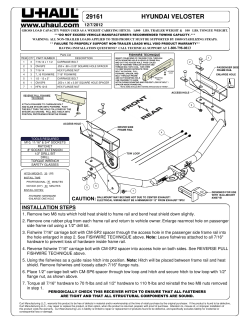
How to Properly Close Hinged & Bolted Manway Nomenclature Illustration
Hinged & Bolted Manway Nomenclature Illustration How to Properly Close a Tank Car Manway It is the shipper’s responsibility to ensure there are no contents of the tank car leaking from the manway before it is shipped. Eliminating leaks around a hinged & bolted manway protects against the risks to life, property, & the environment. By following these steps, an operator can achieve a consistent, high-level, process of assembling a hinged & bolted manway. RIDE-TIGHT R The key to eliminating NAR’s around a hinged & bolted manway requires a high-level process of assembly to ensure leak-free performance over a broad range of temperatures & pressures. Common elements to consider when assembling a hinged & bolted manway include: Gasket-contact surface finish without unacceptable imperfections Suitable gasket Maintaining sufficient contact pressure on the manway cover, manway nozzle, & gasket surfaces (i.e., gasket stress) Condition of the eyebolt Maintaining sufficient contact pressure must consider the maximum & minimum temperature range & the internal pressure the joint may experience in service Bolt stretch, or relaxation, or gasket relaxation, or flow, may result because of changes in temperature & pressure Mechanical failure of an eyebolt may result from corrosion, fatigue, galling, self-loosening, stress corrosion cracking, & wear Safety@EthanolRFA.org www.EthanolRFA.org The information contained herein, though believed to be accurate at the time of publication, should not be considered as legal advice or as a substitute for developing specific company operating guidelines. The authors make no warranty, expressed or implied, or assume any legal liability or responsibility for the accuracy, completeness, or applicability of the information presented in this document. Copyright © 2014 Renewable Fuels Association. All Rights Reserved. Follow these steps to ensure leak-free performance of a hinged & bolted manway 1. 2. Inspect the Manway Area Clean as necessary to observe imperfections. Replace gaskets that have indications of abrasion, cuts, tears, or other damage that may affect the fluid sealing capability. When there is a need to replace a gasket, remove the gasket from the manway cover and inspect the gasket-contact sealing surface on the cover. When transporting a flammable liquid consisting of a mixture or solution having different compositional elements, it is important to choose a gasket material compatible with each element. Replace with gasket suitable for service. Gasket selection should also consider cyclic service conditions. Examine the bolted manway cover for imperfections, bent & broken lugs, damaged manway gasket grooves, & detrimental residue on the gasket & sealing surfaces. Inspect the manway nozzle for imperfections. 4. Identify Eyebolt Number & Tightening Sequence Hinge 2 4 2 5 Star Pattern 6 Hinge Hinge 1 3 8 3 6 Star Pattern 5 1 4 7 4 3 Hinge ClockwiseRotational 2 5 5 1 6 4 3 6 ClockwiseRotational 2 1 Handle Handle Handle Handle 6-Bolt 8-Bolt 6-Bolt 8-Bolt Clean, Examine, & Install New Gaskets 7 8 Recognize the numbering of the eyebolts beginning with the safety eyebolt near the right side of the lifting handle. Follow the numbered sequence in a star pattern when tightening each eyebolt on to the manway. Select a proper tool with appropriate torque setting. For flammable liquid shipment, select a gasket material that is: Within the permissible leak rate to control fugitive emissions; Chemically compatible with the product, including compositional elements; Mechanically compatible with the joint makeup (i.e., not over-compressed or under-compressed [receives proper compression/stress] by assembly bold load); Thermally compatible with the temperature range (i.e., loading, off-loading, and transportation). Download the entire ‘Guidelines for Hinged & Bolted Manway Assembly Flammable Liquids’ at www.EthanolRFA.org/manwayguidelines 3. Inspect & Lubricate the Eyebolts Examine eyebolt threads and hinge pins. Examine each nut to ensure same design. Replace nuts that are broken, cracked, missing or rounded. Use a proper lubricant on the eyebolts, safety eyebolt(s), & bearing surface of the nuts. Ensure the lubricant is compatible with the product. 5. Preferred Torque Sequence and Value VSP CYCLETIGHT® SALCO Nozzle or or Hard Gasket Elastomeric Gasket Sequence Snug Pass (Star Pattern) 1st Pass (Star Pattern) 2nd Pass (Star Pattern) 3rd Pass (Star Pattern) 4th Pass (Clockwise/Rotational) 6-Bolt Snug 75 ft-lbs 160 ft-lbs 250 ft-lbs 8-Bolt Snug 70 ft-lbs 140 ft-lbs 200 ft-lbs 6-Bolt Snug 50 ft-lbs 80 ft-lbs 115 ft-lbs 8-Bolt Snug 45 ft-lbs 70 ft-lbs 90 ft-lbs 250 ft-lbs 200 ft-lbs 115 ft-lbs 90 ft-lbs ALWAYS use approved fastener lubrication on threads and nut bearing surface. ALWAYS start with the #1 bolt. DO NOT use a PIPE WRENCH, this will under torque, resulting in a leak. DO NOT use a CHEATER BAR, this will over torque, bend the manway cover and, result in a leak.
© Copyright 2025











